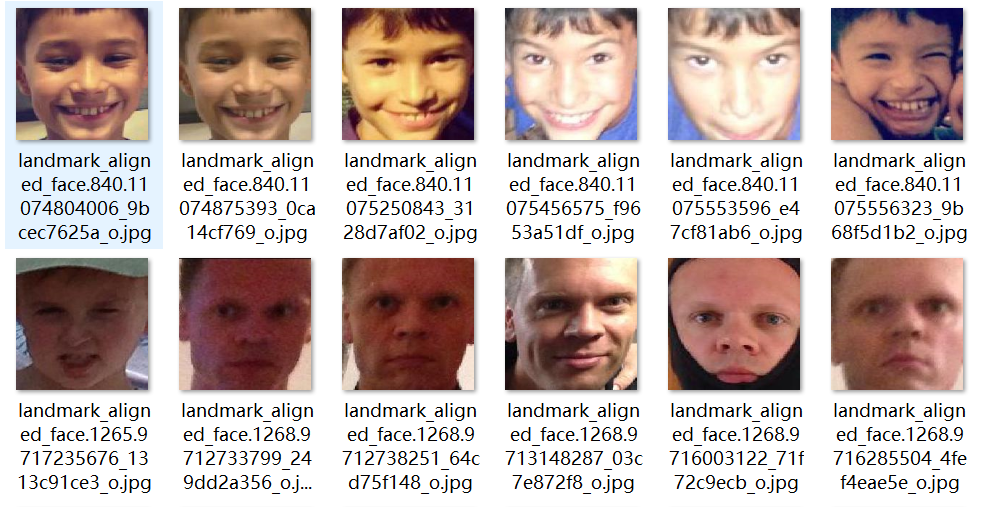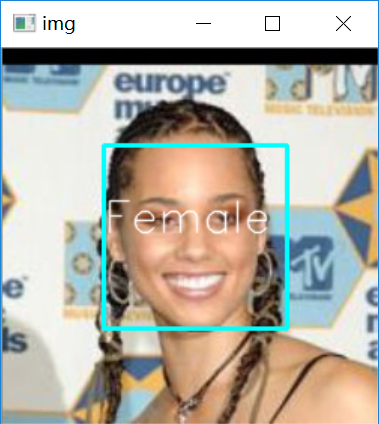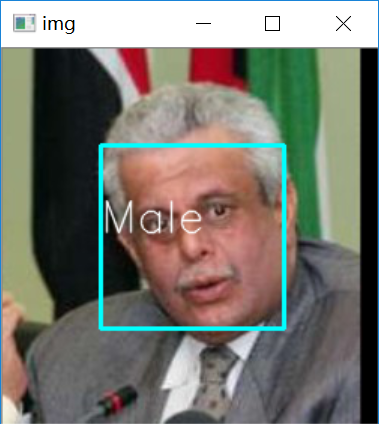keras实现简单性别识别(二分类问题)
keras实现简单性别识别(二分类问题)
第一步:准备好需要的库
- tensorflow 1.4.0
- h5py 2.7.0
- hdf5 1.8.15.1
- Keras 2.0.8
- opencv-python 3.3.0
- numpy 1.13.3+mkl
- 所需要的人脸检测模块
- mtcnn和opencv
- https://pan.baidu.com/s/1rhP7mcnAtiojhk8eiLroEw
第二步:准备数据集:
将性别不同的图片按照不同的分类放到不同的文件夹内。


数据集
https://pan.baidu.com/s/1_f36Gw4PWztUXZWH_jLWcw
import shutil # 读取文件中图片信息根据性别分类图片到对应目录中
dirroot = "D:\\Users\\a\\Pictures\\adience"
f = open(dirroot+"\\fold_frontal_3_data.txt","r")
i = 0 for line in f.readlines():
line = line.split()
dir = line[0] imgName = "landmark_aligned_face."+ line[2] +'.'+ line[1]
if i > 0:
if line[5]== "f":
print("female")
shutil.copy(dirroot+'\\faces\\'+dir+'\\'+imgName, "D:\\pycode\\learn\\data\\validation\\"+imgName)
# 移动图片到female目录
elif line[5]=="m":
print("male")
shutil.copy(dirroot+'\\faces\\'+dir+'\\'+imgName, "D:\\pycode\\learn\\data\\validation\\"+imgName)
# 移动图片到male目录
else:
print("N")
# 未识别男女
i += 1
f.close()
使用ImageDataGenerator,来对图片进行归一化和随机旋转。使用flow_from_directory,来自动产生图片标签生成器。
class Dataset(object):
def __init__(self):
self.train = None
self.valid = None
def read(self, img_rows=IMAGE_SIZE, img_cols=IMAGE_SIZE):
train_datagen = ImageDataGenerator(
rescale=1. / 255,
horizontal_flip=True)
test_datagen = ImageDataGenerator(rescale=1. / 255)
train_generator = train_datagen.flow_from_directory(
train_data_dir,
target_size=(img_rows, img_cols),
batch_size=batch_size,
class_mode='binary')
validation_generator = test_datagen.flow_from_directory(
validation_data_dir,
target_size=(img_rows, img_cols),
batch_size=batch_size,
class_mode='binary')
self.train = train_generator
self.valid = validation_generator
第三部:网络
class Model(object):
def __init__(self):
self.model = Sequential()
self.model.add(Conv2D(32, (3, 3), input_shape=(IMAGE_SIZE,IMAGE_SIZE,3)))
self.model.add(Activation('relu'))
self.model.add(MaxPooling2D(pool_size=(2, 2)))
self.model.add(Conv2D(32, (3, 3)))
self.model.add(Activation('relu'))
self.model.add(MaxPooling2D(pool_size=(2, 2)))
self.model.add(Conv2D(64, (3, 3)))
self.model.add(Activation('relu'))
self.model.add(MaxPooling2D(pool_size=(2, 2)))
self.model.add(Conv2D(64, (3, 3)))
self.model.add(Activation('relu'))
self.model.add(MaxPooling2D(pool_size=(2, 2)))
self.model.add(Flatten())
self.model.add(Dense(64))
self.model.add(Activation('relu'))
self.model.add(Dropout(0.85))
self.model.add(Dense(1))
self.model.add(Activation('sigmoid'))
def train(self, dataset, batch_size=batch_size, nb_epoch=epochs):
self.model.compile(loss='binary_crossentropy',
optimizer='adam',
metrics=['accuracy'])
self.model.fit_generator(dataset.train,
steps_per_epoch=nb_train_samples // batch_size,
epochs=epochs,
validation_data=dataset.valid,
validation_steps=nb_validation_samples//batch_size)
def save(self, file_path=FILE_PATH):
print('Model Saved.')
self.model.save_weights(file_path)
def load(self, file_path=FILE_PATH):
print('Model Loaded.')
self.model.load_weights(file_path)
def predict(self, image):
# 预测样本分类
img = image.resize((1, IMAGE_SIZE, IMAGE_SIZE, 3))
img = image.astype('float32')
img /= 255
#归一化
result = self.model.predict(img)
print(result)
# 概率
result = self.model.predict_classes(img)
print(result)
# 0/1
return result[0]
def evaluate(self, dataset):
# 测试样本准确率
score = self.model.evaluate_generator(dataset.valid,steps=2)
print("样本准确率%s: %.2f%%" % (self.model.metrics_names[1], score[1] * 100))
第四部:主程序
if __name__ == '__main__':
dataset = Dataset()
dataset.read() model = Model()
model.load()
model.train(dataset)
model.evaluate(dataset)
model.save()
第五步:识别程序
opencv检测模块版
#!/usr/bin/env python
"""
从摄像头中获取图像实时监测
"""
import numpy as np
import cv2
from GenderTrain import Model def detect(img, cascade):
"""
检测图像是否含有人脸部分
:param img: 待检测帧图像
:param cascade: 面部对象检测器
:return: 面部图像标记
"""
rects = cascade.detectMultiScale(img, scaleFactor=1.3, minNeighbors=4, minSize=(30, 30),
flags=cv2.CASCADE_SCALE_IMAGE)
if len(rects) == 0:
return []
rects[:,2:] += rects[:,:2]
return rects def draw_rects(img, rects, color):
"""
根据图像标记人脸区域与性别
:param img:
:param rects:
:param color:
:return:
"""
for x, y, w, h in rects:
face = img[x:x+w,y:y+h]
face = cv2.resize(face,(224,224))
if gender.predict(face)==1:
text = "Male"
else:
text = "Female"
cv2.rectangle(img, (x, y), (w, h), color, 2)
cv2.putText(img, text, (x, h), cv2.FONT_HERSHEY_SIMPLEX, 2.0, (255, 255, 255), lineType=cv2.LINE_AA) if __name__ == '__main__':
haar__cascade_path = "D:\\opencv\\sources\\data\\haarcascades\\haarcascade_frontalface_default.xml" cascade = cv2.CascadeClassifier( haar__cascade_path)
cam = cv2.VideoCapture(0)
# 获取摄像头视频
gender = Model()
gender.load()
# 加载性别模型
while True:
ret, img = cam.read()
# 读取帧图像
rects = detect(img, cascade)
print(rects)
vis = img.copy()
draw_rects(vis, rects, (0, 255, 0))
cv2.imshow('Gender', vis)
if cv2.waitKey(5) == 27:
break
cv2.destroyAllWindows()
MTCNN检测版
"""
从摄像头中获取图像实时监测
"""
import PIL
import numpy as np
import detect_face
import tensorflow as tf
import cv2
from GenderTrain import Model with tf.Graph().as_default():
gpu_options = tf.GPUOptions(per_process_gpu_memory_fraction=0.5)
sess = tf.Session(config=tf.ConfigProto(gpu_options=gpu_options, log_device_placement=False))
with sess.as_default():
pnet, rnet, onet = detect_face.create_mtcnn(sess,
'E:\\pycode\\real-time-deep-face-recognition-master\\20170512-110547')
minsize = 20 # minimum size of face
threshold = [0.6, 0.7, 0.7] # three steps's threshold
factor = 0.709 # scale factor
margin = 44
frame_interval = 3
batch_size = 1000
image_size = 182
input_image_size = 160 def draw_rects(img, rects, color):
"""
根据图像标记人脸区域与性别
:param img:
:param rects:
:param color:
:return:
"""
for x, y, w, h in rects:
face = img[x:x+w,y:y+h]
face = cv2.resize(face,(224,224))
if gender.predict(face)==1:
text = "Male"
else:
text = "Female"
cv2.rectangle(img, (x, y), (w, h), color, 2)
cv2.putText(img, text, (x, h), cv2.FONT_HERSHEY_SIMPLEX, 2.0, (255, 255, 255), lineType=cv2.LINE_AA) if __name__ == '__main__':
cam = cv2.VideoCapture(0)
# 获取摄像头视频
gender = Model()
gender.load()
# 加载性别模型
while True:
ret, img = cam.read()
# 读取帧图像
bounding_boxes, _ = detect_face.detect_face(img, minsize, pnet, rnet, onet, threshold, factor)
# 读取帧图像
for face_position in bounding_boxes:
face_position = face_position.astype(int)
print(face_position[0:4])
rects = [[face_position[0], face_position[1], face_position[2], face_position[3]]]
vis = img.copy()
draw_rects(vis, rects, (255, 255, 255))
cv2.imshow('Gender', vis)
if cv2.waitKey(5) == 27:
break
cv2.destroyAllWindows()
完全版
import os
import random
import cv2
import numpy as np
from tensorflow.contrib.keras.api.keras.preprocessing.image import ImageDataGenerator,img_to_array
from tensorflow.contrib.keras.api.keras.models import Sequential
from tensorflow.contrib.keras.api.keras.layers import Dense, Dropout, Activation, Flatten
from tensorflow.contrib.keras.api.keras.layers import Conv2D, MaxPooling2D
from tensorflow.contrib.keras.api.keras.optimizers import SGD IMAGE_SIZE = 182
# 训练图片大小
epochs = 150#原来是50
# 遍历次数
batch_size = 32
# 批量大小
nb_train_samples = 512*2
# 训练样本总数
nb_validation_samples = 128*2
# 测试样本总数
train_data_dir = 'D:\\code\\learn\\data_sex\\train_data\\'
validation_data_dir = 'D:\\data_sex\\test_data\\'
# 样本图片所在路径
FILE_PATH = 'Gender_new.h5'
# 模型存放路径
class Dataset(object): def __init__(self):
self.train = None
self.valid = None def read(self, img_rows=IMAGE_SIZE, img_cols=IMAGE_SIZE):
train_datagen = ImageDataGenerator(
rescale=1. / 255,
horizontal_flip=True) test_datagen = ImageDataGenerator(rescale=1. / 255) train_generator = train_datagen.flow_from_directory(
train_data_dir,
target_size=(img_rows, img_cols),
batch_size=batch_size,
class_mode='binary') validation_generator = test_datagen.flow_from_directory(
validation_data_dir,
target_size=(img_rows, img_cols),
batch_size=batch_size,
class_mode='binary') self.train = train_generator
self.valid = validation_generator class Model(object): def __init__(self):
self.model = Sequential()
self.model.add(Conv2D(32, (3, 3), input_shape=(IMAGE_SIZE,IMAGE_SIZE,3)))
self.model.add(Activation('relu'))
self.model.add(MaxPooling2D(pool_size=(2, 2))) self.model.add(Conv2D(32, (3, 3)))
self.model.add(Activation('relu'))
self.model.add(MaxPooling2D(pool_size=(2, 2))) self.model.add(Conv2D(64, (3, 3)))
self.model.add(Activation('relu'))
self.model.add(MaxPooling2D(pool_size=(2, 2))) self.model.add(Flatten())
self.model.add(Dense(64))
self.model.add(Activation('relu'))
self.model.add(Dropout(0.5))
self.model.add(Dense(1))
self.model.add(Activation('sigmoid')) def train(self, dataset, batch_size=batch_size, nb_epoch=epochs): self.model.compile(loss='binary_crossentropy',
optimizer='adam',
metrics=['accuracy'])
self.model.fit_generator(dataset.train,
steps_per_epoch=nb_train_samples // batch_size,
epochs=epochs,
validation_data=dataset.valid,
validation_steps=nb_validation_samples//batch_size) def save(self, file_path=FILE_PATH):
print('Model Saved.')
self.model.save_weights(file_path) def load(self, file_path=FILE_PATH):
print('Model Loaded.')
self.model.load_weights(file_path) def predict(self, image):
# 预测样本分类
img = image.resize((1, IMAGE_SIZE, IMAGE_SIZE, 3))
img = image.astype('float32')
img /= 255 #归一化
result = self.model.predict(img)
print(result)
# 概率
result = self.model.predict_classes(img)
print(result)
# 0/1 return result[0] def evaluate(self, dataset):
# 测试样本准确率
score = self.model.evaluate_generator(dataset.valid,steps=2)
print("样本准确率%s: %.2f%%" % (self.model.metrics_names[1], score[1] * 100)) if __name__ == '__main__':
dataset = Dataset()
dataset.read() model = Model()
model.load()
model.train(dataset)
model.evaluate(dataset)
model.save()


keras实现简单性别识别(二分类问题)的更多相关文章
- keras框架下的深度学习(二)二分类和多分类问题
本文第一部分是对数据处理中one-hot编码的讲解,第二部分是对二分类模型的代码讲解,其模型的建立以及训练过程与上篇文章一样:在最后我们将训练好的模型保存下来,再用自己的数据放入保存下来的模型中进行分 ...
- 1.keras实现-->自己训练卷积模型实现猫狗二分类(CNN)
原数据集:包含 25000张猫狗图像,两个类别各有12500 新数据集:猫.狗 (照片大小不一样) 训练集:各1000个样本 验证集:各500个样本 测试集:各500个样本 1= 狗,0= 猫 # 将 ...
- 基于Keras的imdb数据集电影评论情感二分类
IMDB数据集下载速度慢,可以在我的repo库中找到下载,下载后放到~/.keras/datasets/目录下,即可正常运行.)中找到下载,下载后放到~/.keras/datasets/目录下,即可正 ...
- [DeeplearningAI笔记]卷积神经网络4.1-4.5 人脸识别/one-shot learning/Siamase网络/Triplet损失/将面部识别转化为二分类问题
4.4特殊应用:人脸识别和神经网络风格转换 觉得有用的话,欢迎一起讨论相互学习~Follow Me 4.1什么是人脸识别 Face verification人脸验证 VS face recogniti ...
- xgb, lgb, Keras, LR(二分类、多分类代码)
preprocess # 通用的预处理框架 import pandas as pd import numpy as np import scipy as sp # 文件读取 def read_csv_ ...
- C++开发人脸性别识别教程(16)——视频人脸性别识别
在之前的博文中我们已经可以顺利驱动摄像头来採集源图像.在这篇博文中将正式为其加入性别识别的代码,实现摄像头视频的人脸性别识别. 一.人脸检測 在得到摄像头採集的源图像之后,首先要做的就是对其进行人脸检 ...
- C++开发人脸性别识别教程(5)——通过FaceRecognizer类实现性别识别
在之前的博客中已经攻克了人脸检測的问题,我们计划在这篇博客中介绍人脸识别.性别识别方面的相关实现方法. 事实上性别识别和人脸识别本质上是相似的,由于这里仅仅是一个简单的MFC开发,主要工作并不在算法研 ...
- 基于深度学习的人脸性别识别系统(含UI界面,Python代码)
摘要:人脸性别识别是人脸识别领域的一个热门方向,本文详细介绍基于深度学习的人脸性别识别系统,在介绍算法原理的同时,给出Python的实现代码以及PyQt的UI界面.在界面中可以选择人脸图片.视频进行检 ...
- 基于OpenCV性别识别
叙述性说明 所谓的性别识别推断检测到的面部是男性还是女性.它是一个二值分类问题. 识别算法可以用于SVM,BP神经网络.LDA,PCA,PCA+LDA等等.OpenCV官网给出的文档是基于Fisher ...
随机推荐
- Day4_名称空间与作用域
函数嵌套: 函数的嵌套调用:在调用一个函数的过程中,又调用了了另外一个函数 比如说比较多个值的大小,可以利用这种方法: def max2(x,y): if x > y: return x els ...
- 【转】H.264RTP封包原理
原文地址:H.264RTP封包原理 作者:cnp11 1. 引言 随着信息产业的发展,人们对信息资源的要求已经逐渐由文字和图片过渡到音频和视频,并越来越强调获取资源的实时性和互动性.但人们又面 ...
- Awesome Big Data List
https://github.com/onurakpolat/awesome-bigdata A curated list of awesome big data frameworks, resour ...
- [ Java面试题 ]基础篇之一
1.一个".java"源文件中是否可以包括多个类(不是内部类)?有什么限制? 可以有多个类,但只能有一个public的类,并且public的类名必须与文件名相一致. 2.Java有 ...
- Spring Boot【快速入门】
Spring Boot 概述 Build Anything with Spring Boot:Spring Boot is the starting point for building all Sp ...
- All is Over
Noip2017结束,AFO.WC2017上神犇们唱的膜你抄 就是退役的背景音乐了 不管以后何去何从,Oier的生涯对我来说已经终了,找个日子好好回忆一下这么多年的Oi时光,然后写篇博文祭奠 自此 ...
- JavaScript中push ,pop ,concat ,join方法
push 方法 将新元素添加到一个数组中,并返回数组的新长度值. arrayObj.push([item1 [item2[. . . [itemN ]]]]) 说明 push 方法将以新元素出现的顺序 ...
- 前端开发APP,从HBuilder开始~ 【转】
内容简介 介绍目前前端人员开发app的几种方法,具体介绍hbuilder开发app,一扇赞新的大门~ 无所不能的js 最开始js仅仅局限于网页上一些效果,操作网页内容等, 但是nodejs把js带入了 ...
- ORA-01658: 无法为表空间 YJXT 中的段创建 INITIAL 区
oracle 用imp导入数据的时候报错:遇到ORACLE 错误1658: 无法为表空间 MAXDATA 中的段创建 INITIAL 区 解决办法:需要添加数据文件而不是新增表空间,代码如下: alt ...
- Django入门三之urls.py重构及参数传递
1. 内部重构 2. 外部重构 website/blog/urls.py website/website/urls.py 3. 两种参数处理方式 -1. blog/index/?id=1234& ...
